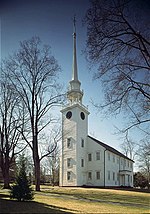Rattlesnake Mountain (Connecticut)

Rattlesnake Mountain is a traprock mountain, 750 feet (230 m) above sea level, located 9 miles (14 km) southwest of Hartford, Connecticut, in the town of Farmington. It is part of the narrow, linear Metacomet Ridge that extends from Long Island Sound near New Haven, Connecticut, north through the Connecticut River Valley of Massachusetts to the Vermont border. Rattlesnake Mountain, a popular outdoor recreation resource of the metropolitan Hartford area, is known for its cliff-top scenic vistas, unique microclimate ecosystems, and rare plant communities. Will Warren's Den, a boulder cave located on the mountain, is a local historic site. Rattlesnake Mountain is traversed by the 51-mile (82 km) Metacomet Trail.
Excerpt from the Wikipedia article Rattlesnake Mountain (Connecticut) (License: CC BY-SA 3.0, Authors, Images).Rattlesnake Mountain (Connecticut)
South Ridge Road,
Geographical coordinates (GPS) Address Nearby Places Show on map
Geographical coordinates (GPS)
| Latitude | Longitude |
|---|---|
| N 41.699722222222 ° | E -72.832777777778 ° |
Address
Town Open Space (Rattlesnake Mountain)
South Ridge Road
06032
Connecticut, United States
Open on Google Maps









